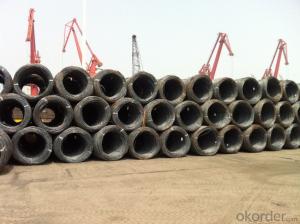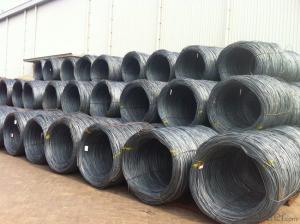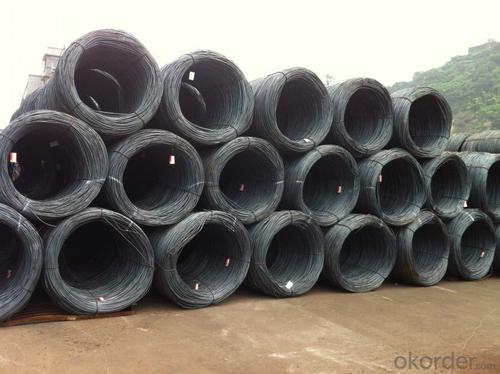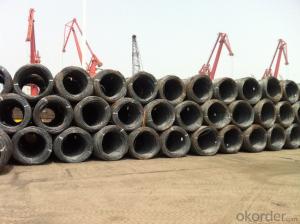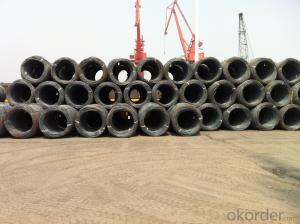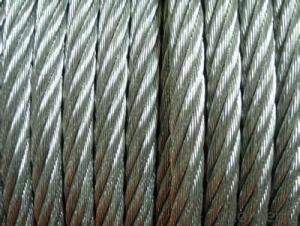Wire rod SAE 1006-1018 with highest quality and lowest price
- Loading Port:
- Tianjin
- Payment Terms:
- TT OR LC
- Min Order Qty:
- 25 m.t.
- Supply Capability:
- 10000 m.t./month
OKorder Service Pledge
OKorder Financial Service
You Might Also Like
Product Description:
OKorder is offering high quality products at great prices with worldwide shipping. Our supplier is a world-class manufacturer of steel, with our products utilized the world over. OKorder annually supplies products to European, North American and Asian markets. We provide quotations within 24 hours of receiving an inquiry and guarantee competitive prices.
Product Applications:
After hot-rolled the products shaped into coil and delivery as finished product, including round, square, rectangular, hexagonal and so on, Since most of the products are round, it is generally called wire rod. Steel wire rod is widely used in construction and manufacturing. Steel wire rod is mainly used for reinforcement of reinforced concrete and welded structure or reprocessed (roberts, nail etc) materials, especially used to produce wire drawing, welding electrode, nails,spring, electronic, precise machinery parts and so on.
Product Advantages:
OKorder's wire rods are durable, strong, and resist corrosion.
Main Product Features:
· Premium quality
· Prompt delivery & seaworthy packing (30 days after receiving deposit)
· Corrosion resistance
· Can be recycled and reused
· Mill test certification
· Professional Service
· Competitive pricing
Product Specifications:
Manufacture: Hot rolled
Grade: SAE1006-1018
Certificates: ISO, SGS, BV, CIQ
Packaging: Export packing, nude packing, In Coils
Grade | Chemical Composition (%) | |||||
C | Mn | S | P | Si | B | |
SAE1006B | 0.03~O.07 | 0.32max | 0.045max | 0.040max | 0.30max | 0.0008min |
Mechanical properties | ||||||
Yield strength(N/mm2) | Tensile strength(N/mm2) | Elongation (%) | ||||
250-280 | 350-380 | ≥32 | ||||
Grade | Chemical Composition (%) | |||||
C | Mn | S | P | Si | B | |
SAE1008B | 0.10max | 0.3~0.50 | 0.050max | 0.040 max | 0.15max | 0.0008 min |
Mechanical properties | ||||||
Yield strength(N/mm2) | Tensile strength(N/mm2) | Elongation (%) | ||||
≥195 | 315-430 | ≥30 | ||||
FAQ:
Q1: Why buy Materials & Equipment from OKorder.com?
A1: All products offered byOKorder.com are carefully selected from China's most reliable manufacturing enterprises. Through its ISO certifications, OKorder.com adheres to the highest standards and a commitment to supply chain safety and customer satisfaction.
Q2: How do we guarantee the quality of our products?
A2: We have established an advanced quality management system which conducts strict quality tests at every step, from raw materials to the final product. At the same time, we provide extensive follow-up service assurances as required.
Q3: How soon can we receive the product after purchase?
A3: Within three days of placing an order, we will begin production. The specific shipping date is dependent upon international and government factors, but is typically 7 to 10 workdays.
Images:
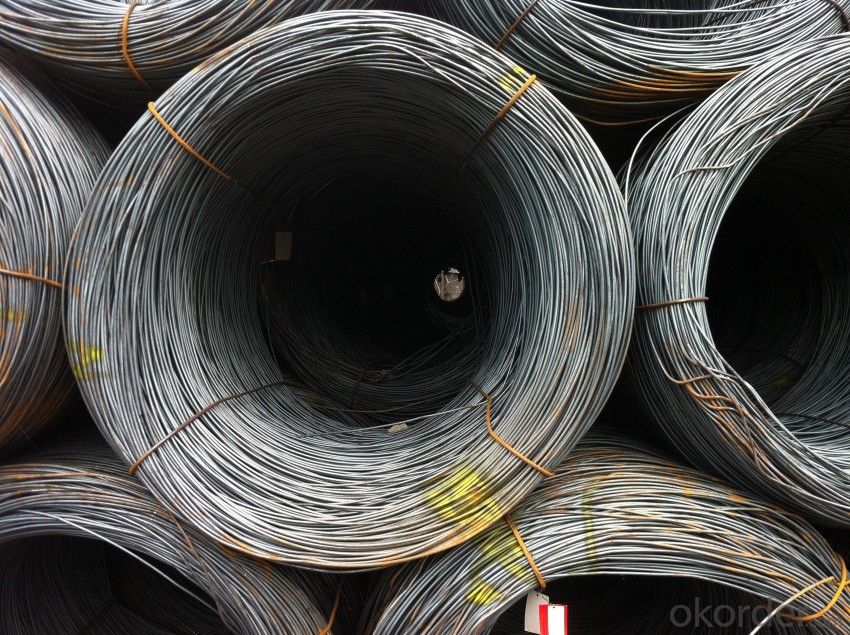

- Q: What are the standard lengths of steel wire rod?
- The standard lengths of steel wire rod can vary depending on the specific application and industry. However, common standard lengths range from 6 to 12 meters (20 to 40 feet).
- Q: What are the disadvantages of using steel wire rods in construction?
- There are a few disadvantages of using steel wire rods in construction: 1. Corrosion: Steel wire rods are susceptible to corrosion, especially in humid and coastal areas. When exposed to moisture and oxygen, steel can rust over time, leading to structural weakness and deterioration. This can compromise the integrity of the construction project and increase maintenance costs. 2. Weight: Steel wire rods are heavy, which can make transportation and installation more challenging. The added weight can also put additional stress on the foundation and supporting structures, potentially leading to structural issues over time. 3. Limited flexibility: Steel wire rods have limited flexibility compared to other construction materials like concrete or timber. This can make it difficult to accommodate complex architectural designs or unique construction requirements. 4. Cost: Steel wire rods can be expensive, especially if high-quality materials are required. Additionally, the cost of transportation, installation, and maintenance can add up, making it a less cost-effective option for some construction projects. 5. Thermal conductivity: Steel has a high thermal conductivity, meaning it can transfer heat quickly. This can lead to increased energy consumption and higher heating or cooling costs in buildings constructed with steel wire rods. 6. Environmental impact: Steel production is resource-intensive and can have a significant environmental impact. The extraction and manufacturing processes emit greenhouse gases and contribute to pollution. Additionally, the disposal of steel wire rods at the end of their lifespan can also pose challenges from an environmental standpoint. Overall, while steel wire rods have numerous advantages in construction, it is essential to consider these disadvantages and evaluate alternative materials based on the specific project requirements, environmental concerns, and budget constraints.
- Q: What are the common manufacturing defects in steel wire rod?
- Some common manufacturing defects in steel wire rods are surface cracks, internal voids, inconsistent dimensions, and improper chemical composition.
- Q: What are the main factors affecting the market competition of steel wire rod?
- The main factors affecting the market competition of steel wire rod include the level of demand for steel wire rod, the number and competitiveness of market players, the availability and cost of raw materials, technological advancements, government regulations and policies, and global economic conditions. Additionally, factors such as production efficiency, product quality, brand reputation, and customer relationships also play a significant role in determining market competition.
- Q: What are the different machinability testing methods for steel wire rod?
- There are several machinability testing methods available for steel wire rod. Some of the common methods used in industry include: 1. Turning Test: This method involves machining the steel wire rod using a lathe or turning machine. The cutting parameters such as cutting speed, feed rate, and depth of cut are varied to evaluate the machinability of the material. The tool wear, surface finish, and chip formation are observed and analyzed to assess the machinability characteristics. 2. Drilling Test: In this method, a drilling machine is used to create holes in the steel wire rod. The drilling parameters such as cutting speed, feed rate, and drill geometry are adjusted to determine the machinability. The hole quality, chip formation, and tool wear are examined to evaluate the performance of the material during drilling. 3. Tapping Test: Tapping is a common machining operation performed on steel wire rods to create threaded holes. In this test, the steel wire rod is tapped using a tapping tool. The torque required, tool life, and thread quality are assessed to determine the machinability of the material. 4. Grinding Test: Grinding is a precision machining process used to remove material from the steel wire rod. In this test, the steel wire rod is ground using a grinding wheel or abrasive belt. The grinding parameters such as grinding speed, feed rate, and grinding wheel specification are adjusted to evaluate the machinability. The surface roughness, material removal rate, and grinding wheel wear are analyzed to assess the performance of the material during grinding. 5. Hardness Test: Machinability can also be indirectly assessed by measuring the hardness of the steel wire rod. Hardness is an important mechanical property that affects the machinability of a material. Various hardness testing methods like Rockwell, Brinell, or Vickers hardness tests can be performed to determine the hardness of the steel wire rod. Higher hardness values indicate lower machinability, while lower hardness values suggest better machinability. These testing methods help manufacturers and engineers to select the most suitable machining parameters and tools for processing steel wire rods. By understanding the machinability characteristics, they can optimize the machining operations and improve productivity while minimizing tool wear and material waste.
- Q: What are the different types of steel wire rod drawing dies?
- There are several different types of steel wire rod drawing dies, each designed for specific applications and materials. 1. Single crystal diamond dies: These dies are made from a single crystal diamond and are known for their high wear resistance and durability. They are commonly used for drawing high carbon steel wires and other hard materials. 2. Polycrystalline diamond (PCD) dies: PCD dies are made from multiple small diamond grains that have been bonded together. They offer good wear resistance and are suitable for drawing medium to high carbon steel wires, stainless steel wires, and non-ferrous materials. 3. Tungsten carbide dies: These dies are made from a combination of tungsten and carbon, resulting in a material that is extremely hard and wear-resistant. They are commonly used for drawing low to medium carbon steel wires and non-ferrous wires. 4. Natural diamond dies: These dies are made from natural diamond, which offers excellent wear resistance and a smooth surface finish. They are typically used for drawing fine and ultra-fine wires, such as those used in the electronics industry. 5. PCD-coated dies: These dies have a layer of polycrystalline diamond coating applied to a tungsten carbide or steel substrate. They combine the wear resistance of PCD with the toughness of the substrate material, making them suitable for drawing a wide range of materials, including steel, stainless steel, and non-ferrous alloys. 6. Ceramic dies: Ceramic dies are made from materials such as tungsten carbide, alumina, or zirconia. They offer good wear resistance and can be used for drawing steel wires, stainless steel wires, and non-ferrous materials. Overall, the choice of steel wire rod drawing die depends on the specific application, wire material, and desired quality of the finished product. It is important to select the appropriate type of die to ensure optimal performance and longevity.
- Q: What are the common production processes for vanadium-coated steel wire rod?
- The common production processes for vanadium-coated steel wire rod typically involve several steps. First, the steel wire rod is cleaned and pre-treated to remove any impurities or contaminants. Then, it undergoes a process called vanadization, where a layer of vanadium is applied onto the surface of the wire rod through a chemical or electroplating method. This vanadium coating provides enhanced properties such as increased strength and corrosion resistance. Finally, the wire rod is subjected to further treatments such as annealing, cooling, and quality testing to ensure it meets the desired specifications and standards before being used in various applications.
- Q: How is the steel wire rod market affected by fluctuations in foreign exchange rates?
- Fluctuations in foreign exchange rates have a significant impact on the steel wire rod market. As steel wire rod is a globally traded commodity, changes in currency exchange rates directly affect its pricing and competitiveness in international markets. A stronger domestic currency compared to foreign currencies can make steel wire rod exports more expensive, reducing demand and potentially leading to a decline in market share. Conversely, a weaker domestic currency can make exports more affordable, increasing demand and potentially expanding market opportunities. Therefore, foreign exchange rate fluctuations play a crucial role in shaping the dynamics of the steel wire rod market.
- Q: How is steel wire rod tested for internal defects?
- Steel wire rod is tested for internal defects using non-destructive testing methods such as ultrasonic testing or electromagnetic testing. These techniques involve passing high-frequency waves or electromagnetic fields through the rod to identify any internal flaws or defects. By analyzing the reflected waves or electromagnetic signals, any hidden defects such as cracks, voids, or inclusions can be detected, enabling manufacturers to ensure the quality and integrity of the steel wire rod.
- Q: What are the different types of steel wire rod surface cleaning techniques?
- Various industries employ several different techniques to clean the surface of steel wire rods, removing impurities, rust, scale, or other contaminants. Some commonly used techniques include: 1. Mechanical Cleaning: The surface of steel wire rods is cleaned through mechanical abrasion using wire brushes, steel wool, or abrasive pads. This method effectively removes loose rust, scale, or paint. 2. Chemical Cleaning: Chemicals or solvents are used to dissolve or loosen contaminants on the surface. Acidic or alkaline solutions are typically employed for this purpose. The cleaning solution is applied to the steel wire rods, breaking down impurities, and rinsed off with water to remove residue. 3. Shot Blasting: High-speed steel shots or grits are propelled against the surface of steel wire rods using compressed air or centrifugal force. This technique efficiently removes rust, scale, or contaminants. 4. Pickling: Specifically designed for removing oxide layers, pickling involves immersing the steel wire rods in an acidic solution, usually hydrochloric acid. This dissolves the oxide layers, resulting in a clean and smooth surface. 5. Ultrasonic Cleaning: High-frequency sound waves create tiny bubbles in a cleaning solution, which effectively remove contaminants from the surface of steel wire rods. This technique is commonly used for delicate or intricate parts, with the rods submerged in a tank filled with the cleaning solution and subjected to ultrasonic waves to dislodge impurities. These techniques are commonly employed to clean the surface of steel wire rods, with the choice depending on the specific requirements of the industry and desired level of cleanliness.
Send your message to us
Wire rod SAE 1006-1018 with highest quality and lowest price
- Loading Port:
- Tianjin
- Payment Terms:
- TT OR LC
- Min Order Qty:
- 25 m.t.
- Supply Capability:
- 10000 m.t./month
OKorder Service Pledge
OKorder Financial Service
Similar products
Hot products
Hot Searches
Related keywords

